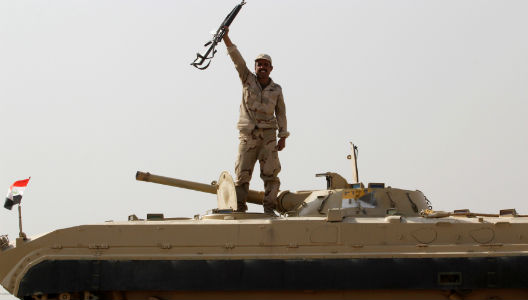 The Islamic State (ISIS) has expanded the territory under their control, which is now larger than the area of the United Kingdom, but this has come at the cost of exposing itself on all sides to enemies and hindering its ability to control its territory.
The Islamic State (ISIS) has expanded the territory under their control, which is now larger than the area of the United Kingdom, but this has come at the cost of exposing itself on all sides to enemies and hindering its ability to control its territory.
In early 2016, ISIS’ borders began to contract, and this evolving jihadist group went from being the “expanding caliphate” to become more akin to a traditional jihadist organization. Meanwhile, conspiracy theorists believed that a number of countries contributed to ISIS’ expansion in order to create a common enemy, so that the Middle East as a region would submit to a new balance of power.
With ISIS’ shrinking hold on land in Syria, Iraq, and Libya, the region is now at a turning point—particularly given recent developments such as Turkey’s entrance as a clear player in the conflict. Furthermore, there are indications that the conflict is coming closer to ISIS’s main cities of Raqqa and Mosul, which would herald the fall of the organization’s geographic structure. Whatever happens in these regions will not simply be determined by a battle for Raqqa or Mosul, but by follow-up battles after ISIS is eliminated.
The international powers currently allied in the war against ISIS see the organization as a common enemy, yet at the same time, many see each other as prospective enemies, and Syrian and regional groups have become the pawns for these powers’ proxy wars. There is no doubt that the decrease in territory under ISIS control will result in more traditional battles, yet also fiercer ones. ISIS troops will likely gather in its strongholds of Raqqa and Mosul after retreating from the surrounding areas. If Raqqa and Mosul are overthrown, this could lead to a grueling guerilla war pitting organized forces against ISIS cells. Former members of ISIS with experience and high levels of training could form cells, which could relocate to neighboring countries like Tunisia, Saudi Arabia, or Egypt, intent on spreading chaos and conflict.
The United States looks to Syrian Kurds as a partner with the power to combat ISIS in Syrian territory. Turkey considers them an extension of the PKK, an armed wing of the Kurdistan Workers’ Party—classified as a terrorist organization in Turkey—which is known for its historical animosity to the Turkish state. Turkey essentially declared war on Kurdish organizations with its Euphrates Shield Operation, which Turkish officials said will target all terrorist organizations on the Syrian-Turkish border. This is a clear message to Kurdish militias, and aims to break their territorial advances towards creating a Kurdish nation on Turkey’s southern borders.
In Iraq, Shiite expansion and associated attacks by Shiite militias—which are supported by the central government in Baghdad and the Iranian Revolutionary Guard, and implicitly by the US government’s tacit silence in many cases—on Arab Sunnis in the region have led many young Sunnis to join ISIS. Documented attacks on Sunnis have continued in places outside ISIS control, which indicates the possibility of sectarian war in these areas.
The fact that the various policies are disconnected from one another is well known, and brings to mind the well-known proverb: when there are too many shepherds, the sheep get lost. These policies are unlikely to change, making the looming question what should be done about ISIS’ fighters once the terrorist organization collapses? Defeating ISIS militarily, despite all the complications of coordinating multiple proxy wars in the shadow of the Syrian civil war, is doable. However, there will then be thousands of battle-hardened fighters feeling frustrated and embittered. There are few to no sources for reintegrating them into society, and many of them are foreign fighters who cannot go back home because of the stigma of fighting for ISIS.
Many of these fighters will seek out ways to continue fighting, likely resorting to more traditional terrorist organization structures. Since ISIS’ formation, it has sought to control oil-rich areas. It intended to break the stereotype of organizations that rely on support from individuals or governments, and instead obtain enough wealth to secure finances and weapons for its members, in its mission to extend control into new areas, taking advantage of countries’ support for dictatorships in Arab Spring countries and widespread feelings of frustration and injustice.
However, as a result of Syria and Iraq’s geography—which is largely open plain—ISIS has not been able to defend itself and is now trying to expand towards mountainous regions, which makes combat more difficult. Yemen may be the organization’s next stop, given its difficult terrain, the country’s security vacuum, and sectarian conflict. Furthermore, Yemen is an oil-producing nation, located alongside the Bab al-Mandeb Strait, an important waterway. Many Yemenis have also lost their source of income as a result of fighting in the country, and ISIS will use these human resources to expand its ranks of combatants.
ISIS will not be eliminated by bombing areas under its control, or forming military alliances to defeat it. Rather, it will be eliminated by ending sectarian war in the region: by stopping proxy wars, especially Iran’s, in the region, and bringing an end to injustice in the countries of the Arab Spring.
Feras Hanoush is an activist from Raqqa, a former doctor with Médecins Sans Frontières in Syria, and a member of Raqqa is Being Slaughtered Silently.
Image: Photo: Member of Iraqi security forces gestures as a convoy advances on the outskirts of Mosul, to fight against Islamic State militants, in Kirkuk, Iraq, October 12, 2016. REUTERS/Ako Rasheed
